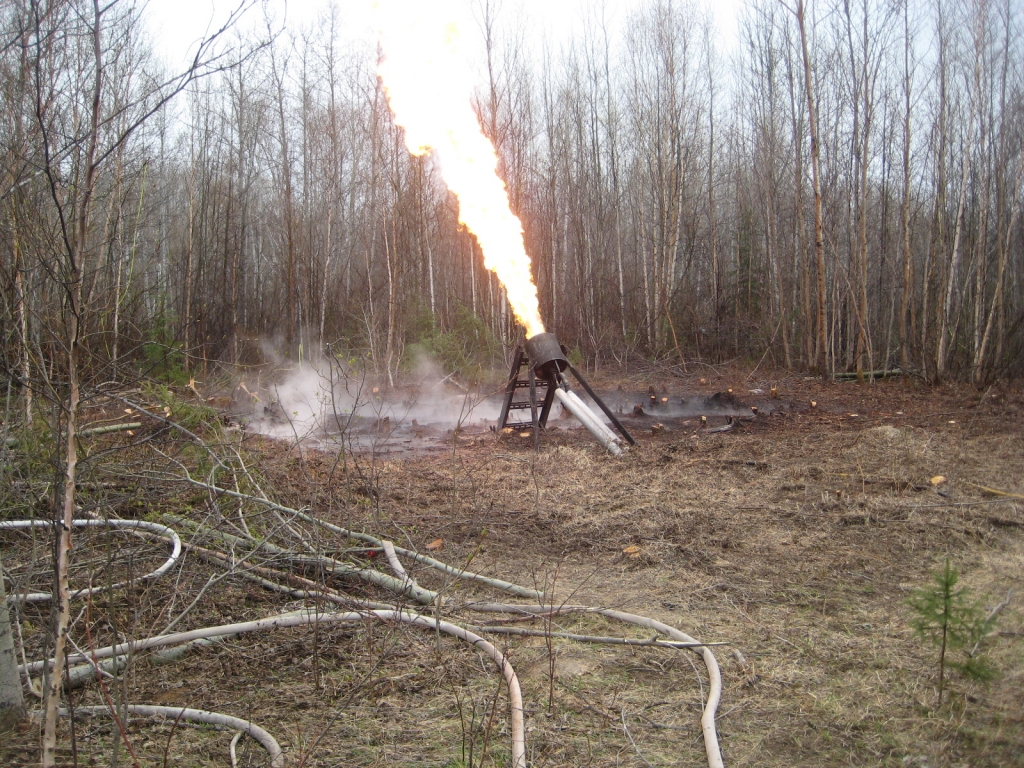Incineration of a massive fuel cache at an abandoned mine near Sachigo Lake has finished, but the community is cautioning that much work remains to bring the land back to the way it once was.
Work crews with Ontario’s Ministry of Northern Development and Mines finished burning off nearly 840,000 litres of fuel left at an old mine site at Lingman Lake on May 20. The crews had been working at the site, 47 kms west of Sachigo Lake, since April 21.
Sachigo Lake First Nation Chief Titus Tait said that the incineration of the fuel is a relief for his community, especially as forest fire season approaches.
But Tait emphasized that the work done to date is only phase one. Cleanup efforts are still needed on closing the mineshaft, removing left over equipment and testing soil and water in the area for contamination.
“The immediate action needed, in terms of burning off of fuel, that’s been resolved,” Tait said. “But in the long term there is still a lot of work to be done. It is an old mine, and everything they brought in to start a mine is still there.”
Sachigo Lake has been pressing the government to cleanup the site since the 1980s, after Twin Lakes Gold Mines brought in all the equipment and fuel needed for its underground exploration of the site and then abandoned it all.
A number of independent and government assessments have since determined that some of the fuel tanks were leaking.
Tait said the community has outstanding concerns over water contamination, noting that many of the lakes and rivers around Sachigo Lake First Nation pass through the Lingman Lake area.
“We have to protect our river systems from fuel or other chemicals getting into the watershed,” he said.
During the incineration work, a large number of 45-gallon drums of unidentified, potentially hazardous fluids were also removed from the site.
Tait said those drums go to show that there are still many unanswered questions about the materials left on site.
He also emphasized a point he has made repeatedly over the years – that any mining operation in Ontario’s far north should have to follow the same closure regulations as a mine in an urban area.
“We’re no different than an urban area,” Tait said. “A mining company has to be required to get a closure plan in place, and to return the land to the way it was.”
Tait said that returning the land to the way it was is crucial today, as young people from Sachigo Lake are becoming more interested in hunting, fishing and trapping on the community’s traditional lands. He said the open mineshaft, other equipment and potentially contaminated land and water pose a threat for hunters, fishermen and trappers in the area.
Ontario’s Ministry of Northern Development and Mines (MNDM) took the company that now owns the land – Timmins-based Cool Minerals – to court over its lack of a closure plan for the site. The judge gave the company until Oct. 10 to complete a closure plan for the site.
Andrew Morrison, a spokesperson for MNDM, said the government dealt with the stored fuel under an emergency measures provision. He said the government does not have the same authority to deal with the mineshaft and other equipment left at the site unless it poses a “direct threat”.
“With tanks full of fuel and the potential for forest fires, it creates a direct threat unavoidable by other circumstances,” Morrison said. “But with open mineshafts and things like that, those are found in other areas of the province as well. It is not creating an immediate hazard of someone being injured.”
Morrison said that the government expects Cool Minerals’ closure plan to address the next steps in cleaning up the site and monitoring the environment around the site.
As part of the Ministry of Natural Resources’ broadscale monitoring program on fish populations across northern Ontario, fish sampling will take place at Lingman Lake this summer. MNR spokesperson Kathryn Lyzun said MNR staff will send flesh samples from Lingman Lake fish to Ministry of Environment staff during the sampling program, so that the fish can be tested for contamination.
Gold has arrived.










Gold has arrived. Here in the north of Ontario we see vast streams of gold shimmering across the landscape as autumn is here and the the leaves are turning...
I am the product, evolution of many thousands of years as are you. I grew up on the land in the remote far north of Ontario following in the footsteps of my...